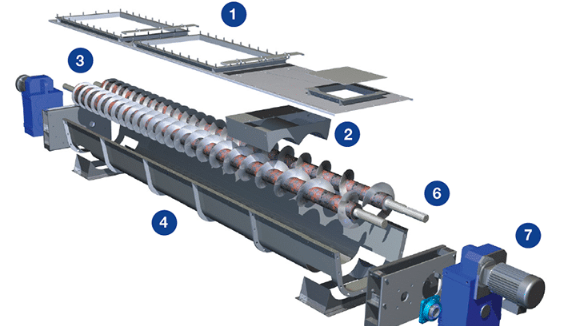Understanding Auger Screw Feeder: Design, Benefits, and Applications

Introduction
Auger Screw Feeder are essential components in various industrial and agricultural applications for the precise and efficient movement of bulk materials. By employing a rotating screw mechanism, these feeders transport materials along a defined path, ensuring consistent flow and accurate dosing. This article explores the design, benefits, and applications of Auger Screw Feeder, offering insights into their crucial role in material handling systems.
1. What is an Auger Screw Feeder?
An auger screw feeder is a type of equipment used to move bulk materials from one location to another. It consists of a helical screw (or auger) that rotates within a tube or trough, propelling materials along the feed path. The design ensures a controlled and continuous flow of materials, making it ideal for handling powders, granules, and other bulk substances.
2. Design Features of Auger Screw Feeder
2.1 Construction Materials
Auger Screw Feeder are typically constructed from durable materials such as stainless steel, carbon steel, or other high-strength alloys. Stainless steel is commonly used in food processing and pharmaceutical applications due to its corrosion resistance and ease of cleaning.
2.2 Auger Design
The auger, or screw, is the core component of the feeder. It is designed with a helical flight that rotates to move materials along the feed path. The pitch, diameter, and length of the auger can be customized based on the material being handled and the desired flow rate. Options include single or double augers for different handling capacities.
2.3 Hopper and Feed System
The hopper is the initial container where bulk materials are loaded before being fed into the auger. It is typically designed with a conical or funnel shape to facilitate smooth material flow into the auger. The feed system ensures that materials are consistently delivered to the auger, preventing blockages and ensuring efficient operation.
2.4 Drive Mechanism
The auger screw feeder is powered by a motor or gearbox that drives the rotation of the auger. The drive mechanism can be configured with variable speed controls to adjust the feed rate according to specific requirements. This flexibility allows for precise control of material flow.
2.5 Safety and Maintenance Features
Auger Screw Feeder include safety features such as protective covers and guards to prevent accidents. Maintenance features, like removable covers and accessible components, facilitate easy cleaning and servicing, ensuring the system remains operational and hygienic.
Read also: Innovation Junction: The Intersection of Technology and Accessibility
3. Benefits of Auger Screw Feeder
3.1 Consistent Material Flow
Auger Screw Feeder provide a consistent and controlled flow of materials, reducing the risk of blockages and ensuring smooth operation. This consistency is essential for maintaining process efficiency and achieving accurate dosing.
3.2 Versatility
These feeders are versatile and can handle a wide range of materials, including powders, granules, and pellets. Their adaptability makes them suitable for various industries, including agriculture, food processing, and manufacturing.
3.3 Precise Dosing
The design of Auger Screw Feeder allows for precise control over the flow rate of materials. This precision is crucial for applications that require exact quantities, such as in batch processing and ingredient mixing.
3.4 Reduced Labor Costs
By automating the material handling process, Auger Screw Feeder reduce the need for manual labor. This automation leads to increased efficiency, lower labor costs, and improved safety in the workplace.
3.5 Easy Maintenance
Auger Screw Feeder are designed for ease of maintenance and cleaning. Features such as removable covers and accessible components make it straightforward to perform routine maintenance and ensure the system remains in good working condition.
4. Applications of Auger Screw Feeder
4.1 Agriculture
In the agriculture sector, Auger Screw Feeder are used to handle and transport feed, seeds, and fertilizers. They ensure the efficient distribution of these materials, supporting agricultural operations and enhancing productivity.
4.2 Food Processing
Auger Screw Feeder are employed in food processing plants to transport ingredients such as flour, sugar, and spices. Their hygienic design and precise feeding capabilities are essential for maintaining food safety and quality.
4.3 Pharmaceuticals
In the pharmaceutical industry, Auger Screw Feeder are used to move active pharmaceutical ingredients (APIs), powders, and granules. Their ability to provide accurate dosing and contamination-free handling is crucial for producing high-quality medications.
4.4 Manufacturing
Auger Screw Feeder play a role in manufacturing processes by transporting raw materials, additives, and compounds. They are used in various manufacturing sectors, including plastics, chemicals, and construction materials.
5. Choosing the Right Auger Screw Feeder
5.1 Material Characteristics
Consider the characteristics of the material to be handled, such as particle size, flowability, and bulk density. Choose an auger screw feeder with a design and construction materials suitable for these characteristics.
5.2 Size and Capacity
Determine the required size and capacity of the feeder based on the volume of material to be processed and the space available in your facility. Proper sizing ensures efficient operation and prevents overloading.
5.3 Drive and Control Options
Evaluate the need for drive and control options based on your application. Features such as variable speed drives and automated controls can enhance the precision and efficiency of the system.
5.4 Supplier Expertise
Select a supplier with expertise in designing and manufacturing Auger Screw Feeder. A reputable supplier can provide customized solutions, technical support, and reliable products to meet your specific needs.
6. Maintenance and Troubleshooting
6.1 Regular Inspections
Conduct regular inspections to check for signs of wear, damage, or material build-up. Inspect the auger, hopper, and drive mechanism to ensure they are functioning correctly.
6.2 Cleaning Procedures
Follow recommended cleaning procedures to maintain hygiene and prevent contamination. Use appropriate cleaning agents and methods to ensure the auger screw feeder remains in optimal condition.
6.3 Troubleshooting Common Issues
Address common issues such as uneven feeding, blockages, or mechanical failures promptly. Identifying and resolving these issues helps maintain optimal performance and reduces downtime.
Conclusion
Auger Screw Feeder are integral to efficient material handling systems, offering consistent, precise, and versatile solutions for transporting bulk materials. By understanding their design features, benefits, and applications, you can select the right auger screw feeder for your needs and ensure smooth, effective operation in your industrial processes. Careful consideration of factors such as material characteristics, size, and control options will help you make an informed decision and achieve optimal performance from your auger screw feeder system.






